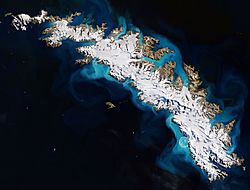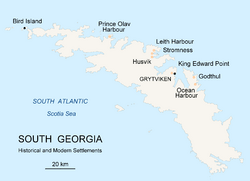South Georgia (island) facts for kids

South Georgia
|
|

Map of South Georgia Island
|
|
| Geography | |
|---|---|
| Location | South Atlantic |
| Coordinates | 54°24′S 36°42′W / 54.4°S 36.7°W |
| Archipelago | South Georgia group |
| Area | 3,528 km2 (1,362 sq mi) |
| Length | 167.4 km (104.02 mi) |
| Width | 37 km (23 mi) |
| Highest elevation | 2,934 m (9,626 ft) |
| Highest point | Mount Paget |
| Largest settlement | King Edward Point |
| Demographics | |
| Population | 32 (summer) 16 (winter) |
South Georgia (Spanish: Isla San Pedro) is a cool island located far away in the southern Atlantic Ocean. It's part of a special area called the British Overseas Territory of South Georgia and the South Sandwich Islands. The main place where people live on the island is called Grytviken. South Georgia is about 167 kilometers (104 miles) long and can be up to 37 kilometers (23 miles) wide. It's quite a distance from other islands, like Coronation Island and Zavodovski Island.
Contents
Discovering South Georgia's Past
Early Explorers and Names
The island of South Georgia was likely first seen in 1675 by a merchant from London named Anthony de la Roché. Because of him, the island was even called Roche Island on some old maps. Later, in 1756, a Spanish ship named León also saw the island. Some historians from Argentina believe it was explored on June 29, 1756, which is St Peter's Day. This is why its Spanish name is Isla San Pedro, meaning "St Peter's Island."
Captain Cook's Visit
A famous sailor named Captain James Cook arrived at South Georgia in 1775 with his ships, HMS Resolution and HMS Adventure. He was the first to land on the island, explore it, and draw maps of its coast. On January 17, 1775, he claimed the island for Britain. He then renamed it 'Isle of Georgia' to honor King George III.
Hunting Seals and Whales
For many years, from 1786 to 1913, people came to South Georgia to hunt seals. Records show 131 visits for sealing during this time, and eight of those trips ended with the ships sinking. Later, from 1909 to 1964, large-scale hunting of whales also took place. Today, you can still find old items from these times, like big iron pots used to melt blubber, old hut ruins, graves, and writings carved into things.
When Argentina Occupied the Island
In 1982, a group of Argentinians arrived at Leith Harbour on March 19. They raised the Argentine flag on the island. A few weeks later, on April 3, during the Falklands War, Argentine naval forces took control of the island. However, British forces quickly took South Georgia back on April 25 in an operation called Operation Paraquet.
Exploring South Georgia's Nature
Climate and Landscape
South Georgia has a very cold climate, known as a polar tundra climate. This means it's too cold for trees to grow. The island is usually covered in snow during the winter months, from April to November. The land is very mountainous, with a long ridge in the middle. There are also many deep inlets (fjords) and bays along the coast. You can also see flat areas along the coast that look like steps. These were formed by ocean waves when the sea level was higher.
Amazing Wildlife and Plants
South Georgia is a very important place for many animals. It's a breeding ground for huge elephant seals, furry fur seals, and beautiful king penguins. The island is also home to two special birds found nowhere else: the South Georgia Pintail and the South Georgia Pipit.
While there are 25 types of plants that naturally grow on South Georgia, about 76 other types of plants have been brought to the island by people.
Protecting the Ecosystem
In 2013, teams of experts removed all 3,500 reindeer from the island. These reindeer had been brought to South Georgia by Norwegian whalers a long time ago for food and hunting. But they started causing problems by eating too many plants and harming the island's natural environment. The reindeer were frozen and sent to the Falkland Islands to be sold.
Good news came in 2018! After many years of hard work, the island was declared free of invasive rodents (like rats). This was a huge success, and the number of South Georgia Pipits has clearly grown since then.
Giant Icebergs and Their Impact
South Georgia is in the path of very large icebergs that float north from Antarctica. In 2004, a huge iceberg called Iceberg A-38 got stuck near the island. This caused big problems for the local wildlife. It disturbed life on the seafloor and blocked the paths that seals and penguins use to find food. In 2020, an even bigger iceberg, Iceberg A-68, which was about the same size as the island itself, was heading towards South Georgia. Luckily, it broke apart before it could hit the island.
See also
 In Spanish: Isla San Pedro (Georgia del Sur) para niños
In Spanish: Isla San Pedro (Georgia del Sur) para niños



